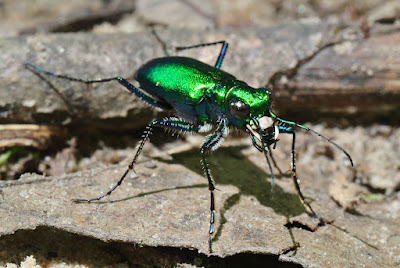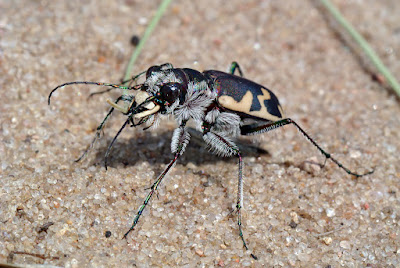"Green in nature is one thing, green in literature another. Nature and letters seem to have a natural antipathy; bring them together and they tear each other to pieces."
― Virginia Woolf
Mornings during May are generally spent birding the Pheasant Branch Creek Corridor for new arrivals, but this migration has been somewhat disappointing ― more birds heard than seen. The order of returning migrants has been a jumbled mess, and it seems like a lot of birds may have taken advantage of favorable winds early on. There are L. peregrina everywhere, and for me they generally signal the beginning of the tailend of warbler migration. However, if you're a regular reader of this blog, you're well aware of my numerous other outdoor interests, and spring presents the perfect opportunity to reacquaint myself with them. And in that sense, Spring Green Preserve is a longtime favorite and it's one of Wisconsin's best State Natural Areas for observing interesting flora and fauna. It's also one of the few places I know of where Chondestes grammacus can be found in impressive numbers.
A positive aspect of prairie birding is at least you can see them even when there's an early spring in terms of foliage. As I previously mentioned, the earlier than normal leaf-out has rendered woodland birding way more challenging than usual this spring.
Spring Green's prairie always has interesting wildflowers, like the presently bloomed Blue-eyed Grass and Bird's Foot Violets, the latter being the host plant for Regal Fritillary.
Ah! Praise natural variation!
The wooded trail section is filled with Wild Geraniums ...
And Starry False Solomon's Seal.
It's also a great spot for Six-spotted Tiger Beetles ...
My favorite location to photograph this species is still the long rock wall at Pope Farm Conservancy, but so far this spring I haven't found any there yet. I need to be super careful photographing them along Spring Gree's forest trail, as it's loaded with Poison Ivy on both sides. I've already had one really bad PI reaction this spring and I don't need another.
Going for the coveted front-angle view ...
Other tiger beetles present at Spring Green were Big Sand, Festive, and still a few Oblique-lined. In contrast to a lackluster birding season, tiger beetling has been exceptionally good. I'm already at 8 of Wisconsin's 16 species, but I doubt I'll go up north for Cow Path and Long-lipped this year.
Ye monstrous Big Sand!
And a couple of Festives ...
Note the maculation differences between these two Festive Tiger Beetles. The one above also has a greener thorax compared to the one below.
There were decent numbers of American Copper and Harvester Butterflies along the trail ...
This individual spent some time on my hand. Sweat contains salt, so when people are sweaty, especially on a hot day, butterflies may land on bare skin to feed on the salt. The sweat provides them with essential minerals that they can't get from flower nectar alone. Additionally, the moisture from sweat can be appealing to butterflies, especially in dry environments like Spring Green Preserve's sand prairie.
I really messed up the focus on this Juvenal's Duskywing Erynnis juvenalis, but it was the only photograph I was able to get before it flew off. This butterfly is named after the Roman poet Juvenal, as its name "juvenalis" means "youthful" in Latin, likely referring to the butterfly's spring flight period.
Juvenal, whose full name was Decimus Iunius Iuvenalis, was a Roman poet who lived during the 1st and 2nd centuries AD. He is best known for his satirical works, particularly his "Satires," which criticize and satirize various aspects of Roman society, including politics, morals, and social life. Juvenal's satires are known for their sharp wit, vivid language, and harsh criticism of the corruption and decadence of his time. He often targeted the wealthy and powerful, as well as societal vices such as greed, vanity, and hypocrisy. There is no direct evidence to suggest that Juvenal owned slaves, as his works do not mention his personal life in detail. However, slavery was a common institution in ancient Rome, and it was not uncommon for people of Juvenal's social class (he was likely of equestrian rank, a class below the senatorial elite) to own slaves. Given the social norms of the time, it is possible that Juvenal may have owned slaves, but there is no definitive evidence either way. As with birds, though, it is likely the case that eventually all common names of critters will be changed to descriptive ones, thus losing any historical link or context unless you know binomial Latin names.
The current water level of the Wisconsin River is high, yet I was delighted to discover several Hairy-necked Tiger Beetles at Sauk and Arena. The large sandbars at Arena are almost completely under water now, but there's still plenty of shoreline habitat for these swift predaceous insects.
Note the front maculation's "G" shape, often used for identification.
Compared to the above photograph, you can see how sunlight renders a warmer brown tone.
Here you can see the Hairy-necked's long mandibles, which are distinctive compared to other tiger beetles. Fortunately, most tiger beetle species have descriptive names, but many also have hairy necks along the thorax and front abdomen. If it were up to me, I would change this beetle's descriptive common name to Long Sickle-mandibled Annoyingly-fast Tiger Beetle.
During the spring, my passion for nature photography takes me on numerous excursions, resulting in a wealth of captivating photographs. However, translating these experiences into engaging blog posts presents a significant challenge. The process of curating content, selecting the most compelling photos, and crafting narratives that do justice to the beauty and significance of each excursion requires considerable time and effort. Despite this challenge, the opportunity to share my love for nature and photography with others makes the endeavor incredibly rewarding.
A Very Brief Birding Update:
Though this spring's warbler migration is about the worst I've experienced in almost 40 years of birding, I'm just shy of 30 parulidae species for spring. It's mostly what I regard as A-level warbler species remaining and it's perfectly fine if I don't see or hear them this year. The the canopy is filling in quickly, but I know they're up there from their cheerful spring songs. My annual trip to Wyalusing State Park will fill in some of the missing birds. Alas, birding is a blend of triumphs and surprises, where we cherish the birds we find and humbly accept those that elude us.
All images © 2024 Mike McDowell






























